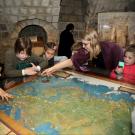As part of the Great London Fire topic, our Primary children visited the Old English Court Museum in Moscow. It is one of the oldest buildings in Moscow built as a private home for a wealthy merchant in the Zaryadie region (famous as the centre of trade in medieval Moscow) and later became home of the first foreign representation in the Russian capital.
Our students were curious to see how the people lived in XVI – XVII centuries in Moscow. They visited the medieval cellars, living rooms and the official reception hall; they learned in what way the Muscovites protected their houses from the fire, what their food was like and how they stored and cooked it, they saw the oven and a huge fireplace and a lot more.
Our secondary students also visited the Old English Court, but their excursion theme was different: they learnt about the birth of Anglo-Russian relations in the age of Ivan IV (the Terrible) and Elizabeth I.
The Old English Court was the first English trading and ambassadorial office in Moscow and served as the first official residence of a Western power in the Russian capital. The house was presented by Ivan the Terrible to a group of English merchants who arrived in Murmansk in 1553 from the court of Edward IV, under the command of Richard Chancellor. They had been sent to search for a northern passage to India, but arrived to Russia instead. Nevertheless, the Englishmen took the opportunity to establish trade links with the Tsar, who welcomed them warmly, provided them with a headquarters and allowed them unlimited duty-free trade.
Our students saw old maps and models of old ships, they got to know that the Englishmen came to Russia thanks to a lucky mistake and how they accommodated this house according to the traditions of Tudor interiors. They were impressed to know that 80% of rope and sails of the British ships were Russian and practically all the candles in Britain were made with Russian wax at that time and windows were covered with Russian mica. Telling us what they were especially interested in at the tour, the students also mentioned a collection of medieval guns and pistols and coins of XV-XVII centuries, accounting documents the British merchants’ had, tsar decrees and a wonderful collection of English medieval books, donated by the British Library.

















